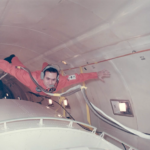Space Awareness
An Apollo 50th Anniversary Moment
Written by: developer
by John Holst, Space Foundation Research Analyst
On March 17, 1966, three hours after they had landed their spacecraft, astronauts Neil Armstrong and David Scott boarded the Navy destroyer U.S.S. Mason. The pair of explorers where shaken, stirred and relieved, and not just because of the nearly 5 meter (15-foot) ocean swells they experienced prior to boarding the destroyer. They'd had an interesting mission.
Armstrong and Scott had just returned from the Gemini VIII mission. It was an ambitious mission, attempting to rendezvous and dock their capsule with a Gemini Agena Target Vehicle (GATV) while orbiting the Earth. NASA had attempted to conduct a similar mission, Gemini VI, five months earlier, only to abort it because that mission's GATV had destroyed itself during ascent. Gemini VIII's mission would prove the concept of two vehicles docking in space -- critical to the Apollo Moon mission.
Both vehicles were launched on March 16, 1966. As planned, the crew launched in Gemini VIII nearly two hours after the GATV launch. The mission was already ahead of the aborted Gemini VI mission: Agena reached orbit, as did Gemini VIII. Houston's mission control gave the go-ahead to conduct rendezvous and docking operations with Agena. The mission proceeded as planned.
A little less than six hours after launch, the two spacecraft successfully rendezvoused for the second time in the Gemini program's history. After maneuvering close to each other, the GATV and Gemini VIII capsule didn't move relative to each other for nearly thirty minutes. Satisfied with the mission's progress during rendezvous, Houston told the two spacecraft pilots to "Go ahead and dock." The docking went well, making history as the two vehicles touched, the first two space vehicles to do so. According to the mission plan, four docking tests were to be accomplished. They were never even begun.
A little over a half hour after docking, Scott noticed both spacecraft had started to roll. That wasn't supposed to happen. They slowly rolled the spacecraft back to the correct attitude. But the spacecraft started rolling again as soon as the control was released. The spinning was getting worse, and spacecraft was running low on fuel. The crew assumed the problem was with Agena and disengaged the Gemini capsule from it. The spinning continued, accelerating the capsule's spin to about one revolution per second. Just moving an arm was a strain.
Thinking quickly and out of other options, the crew used a separate control system, one dedicated to spacecraft reentry maneuvers, to stop the spinning. Armstrong brought the spacecraft under control. The crew eventually determined the circuitry for one of the thrusters was stuck in the "on" position. With the problem maneuvering system off, and the reentry system the only way to control the capsule's attitude, the crew had to start conducting reentry procedures as dictated by circumstances and mission rules.
Nearly 11 hours after launch, the capsule splashed down safely. The capsule had only one air sickness bag -- and it was full.
This article is part of Space Watch: March 2016 (Volume: 15, Issue: 3).


